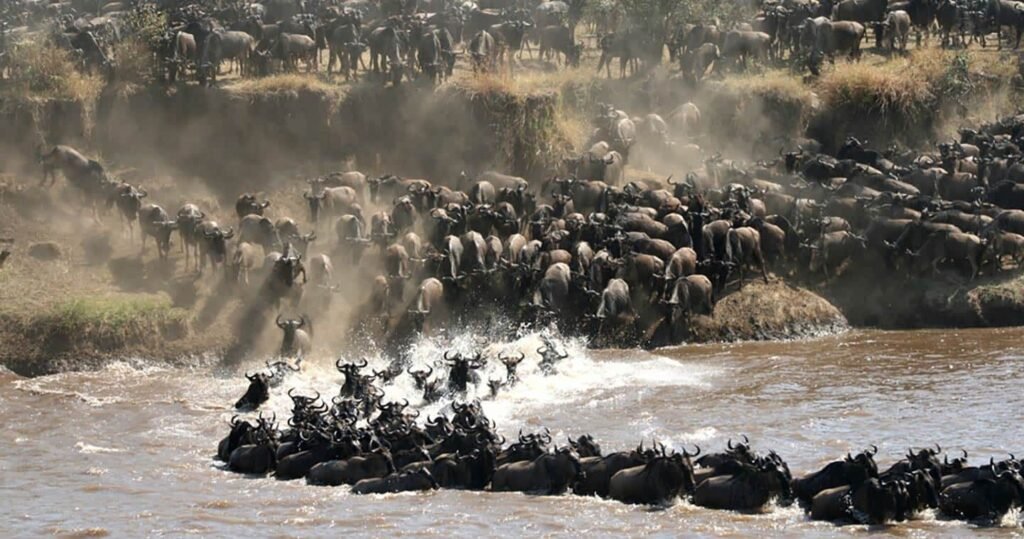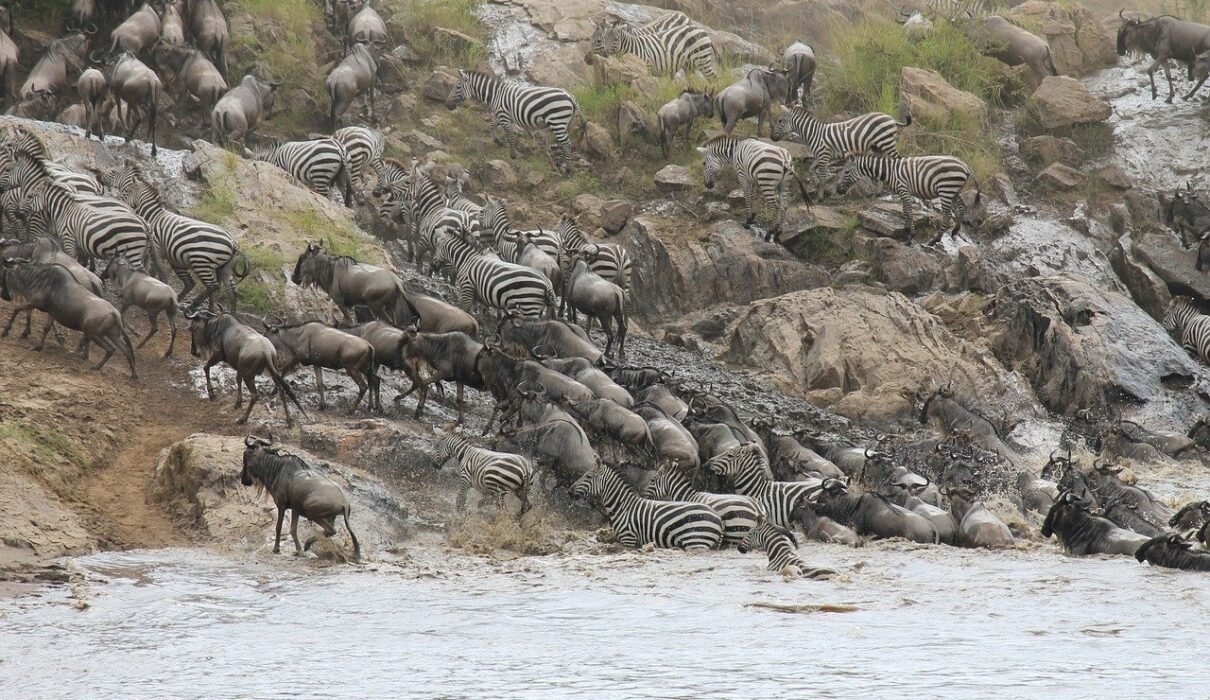The Great Migration is one of the most extraordinary wildlife spectacles in the world, and experiencing it in Tanzania is a dream for many nature enthusiasts. Each year, millions of wildebeest, zebras, and gazelles move across the Serengeti in search of fresh grazing grounds, creating a dramatic cycle of life and death as they face predators and cross perilous rivers. In this guide, we’ll explore why you should see the Great Migration and what makes it a must-see safari experience.
1. Witness the World’s Largest Land Migration
The Great Migration is the largest overland migration of mammals in the world, with over 1.5 million wildebeest, 200,000 zebras, and 500,000 gazelles moving in search of greener pastures. This incredible journey takes place across the Serengeti in Tanzania and the Maasai Mara in Kenya, creating one of nature’s most stunning displays of wildlife movement. Watching this massive migration is not only awe-inspiring but also provides insight into the intricate survival instincts of these animals.
Learn more about the Great Migration with Kilimanjaro Climb Specialist

2. Experience the Dramatic River Crossings
One of the most thrilling aspects of the Great Migration is the river crossings, where thousands of animals plunge into the Mara and Grumeti Rivers. These crossings are packed with tension, as the wildebeest and zebras must navigate fast currents and evade the hungry Nile crocodiles waiting beneath the surface. Witnessing this high-stakes moment is a highlight of any safari.
Best Time to See the Crossings:
- Grumeti River Crossings: Typically occur in June and July in the western Serengeti.
- Mara River Crossings: Take place from July to October in the northern Serengeti.
Book your Great Migration safari with Eddy Tours Safaris
3. See the Circle of Life in Action
The Great Migration is not just a journey of movement; it’s a dramatic stage for life-and-death struggles. As the herds travel, they face predators like lions, leopards, cheetahs, and hyenas. This creates incredible opportunities to witness predator-prey interactions in real-time, giving visitors a front-row seat to the raw power of nature.
Predators to Watch for During the Migration:
- Lions: Often seen hunting wildebeest in open plains.
- Leopards: Found stalking prey in tree-dense areas.
- Cheetahs: Known for their speed, often seen hunting gazelles.
- Hyenas: Opportunistic hunters, often seen scavenging around large herds.
Discover more about Tanzania’s predator-rich ecosystems
4. Multiple Viewing Opportunities Throughout the Year
The beauty of the Great Migration is that it’s a year-round event, with different stages happening in various parts of the Serengeti. Whether you want to witness the calving season in the south or the dramatic river crossings in the north, there’s always something to see.
Migration Timeline:
- January to March: Calving season in the Southern Serengeti. This is a great time to see newborn wildebeest and predators drawn to the area.
- April to June: The herds move through the Western Corridor toward the Grumeti River.
- July to October: River crossings at the Mara River in the northern Serengeti.
- November to December: The herds return to the southern Serengeti.
5. Witness the Calving Season
From January to March, the southern plains of the Serengeti transform into a birthing ground as over 500,000 wildebeest calves are born within a short three-week period. This is an incredible time to visit, as you can witness young calves take their first steps while predators like lions and cheetahs patrol the area in search of easy prey.
- Best Time: January to March in the Ndutu and Southern Serengeti Plains.
- Predator Activity: The high number of calves attracts numerous predators, creating a dramatic scene.
Learn more about calving season safaris in Tanzania
6. Photographer’s Dream Destination
The Serengeti during the Great Migration is a paradise for photographers. The endless plains, golden sunsets, and mass movement of animals create a backdrop like no other. Whether you’re a professional or an amateur photographer, you’ll have countless opportunities to capture the beauty and drama of the migration.
- Iconic Shots: River crossings, predator chases, vast herds against the sunrise, and close-ups of newborn calves.
- Best Time for Photography: June to October during the dry season, when the skies are clear and the wildlife is concentrated around water sources.
Explore photography tips for capturing the Great Migration
7. Explore the Serengeti’s Diverse Ecosystems
The Serengeti National Park is not just home to the Great Migration; it also boasts a range of ecosystems that offer unique wildlife experiences. From the vast open plains to the woodlands, river valleys, and the volcanic landscapes of the Ngorongoro Crater, the Serengeti provides a rich diversity of habitats that support a wide array of wildlife.
Key Ecosystems in the Serengeti:
- Seronera Valley: Known as the “Big Cat capital,” offering excellent opportunities to spot lions, leopards, and cheetahs year-round.
- Western Corridor: Home to the Grumeti River, famous for the migration and large populations of crocodiles and hippos.
- Northern Serengeti: Known for its dramatic Mara River crossings and diverse wildlife.
Learn more about Serengeti’s ecosystems
8. Connect with the Maasai Culture
A trip to see the Great Migration isn’t just about wildlife. Tanzania is home to the Maasai people, a semi-nomadic tribe known for their rich traditions and deep connection with nature. Many safaris offer cultural tours, where you can visit Maasai villages and learn about their way of life, their traditional dances, and their deep respect for the land and animals they coexist with.
Explore Maasai cultural tours in Tanzania
9. Support Conservation Efforts
By choosing a Great Migration safari in Tanzania, you’re contributing to the conservation of this fragile ecosystem. The Serengeti faces threats from poaching, habitat loss, and climate change. Safari tourism helps fund conservation efforts, ensuring that this remarkable wildlife spectacle continues for generations to come.
- Conservation Projects: Many safari operators support local conservation initiatives, including anti-poaching efforts and wildlife research.
- Eco-friendly Lodges: Some lodges operate with sustainability in mind, using solar energy and eco-friendly practices to minimize their impact on the environment.
Learn more about Serengeti conservation efforts
10. A Safari for Every Budget
One of the great things about planning a Great Migration safari in Tanzania is that there are options for every budget. Whether you’re looking for a luxury lodge, a mid-range tented camp, or a budget-friendly camping safari, there are plenty of choices to suit your needs without sacrificing the experience.
- Luxury Safaris: Stay in high-end lodges or camps that offer private game drives, gourmet dining, and stunning views of the migration.
- Mid-range Safaris: Comfortable tented camps and lodges with excellent services and guided game drives.
- Budget Safaris: Group camping safaris offer an affordable way to experience the migration without breaking the bank.
Find the perfect Great Migration safari package
Frequently Asked Questions About the Great Migration
1. What is the best time to see the Great Migration in Tanzania?
The best time to see the migration is between July and October for the river crossings in the northern Serengeti. For calving season, visit between January and March in the southern Serengeti.
2. How long does the Great Migration last?
The migration is a year-round event, with different stages happening at different times. The entire cycle lasts around 12 months as the herds move across the Serengeti and Maasai Mara.
3. Do I need a guide to see the Great Migration?
Yes, guided safaris are highly recommended. Local guides know the best spots for wildlife viewing and can provide insights into the animals’ behaviors.
Ready to See the Great Migration in Tanzania?
The Great Migration safari in Tanzania is a once-in-a-lifetime experience that brings you face-to-face with nature’s most dramatic moments. Whether you’re watching wildebeest cross crocodile-infested rivers or witnessing the birth of a newborn calf, every moment of this safari will leave you in awe.
Start planning your Great Migration safari with Kilimanjaro Climb Specialist
Book your unforgettable adventure with Eddy Tours Safaris

